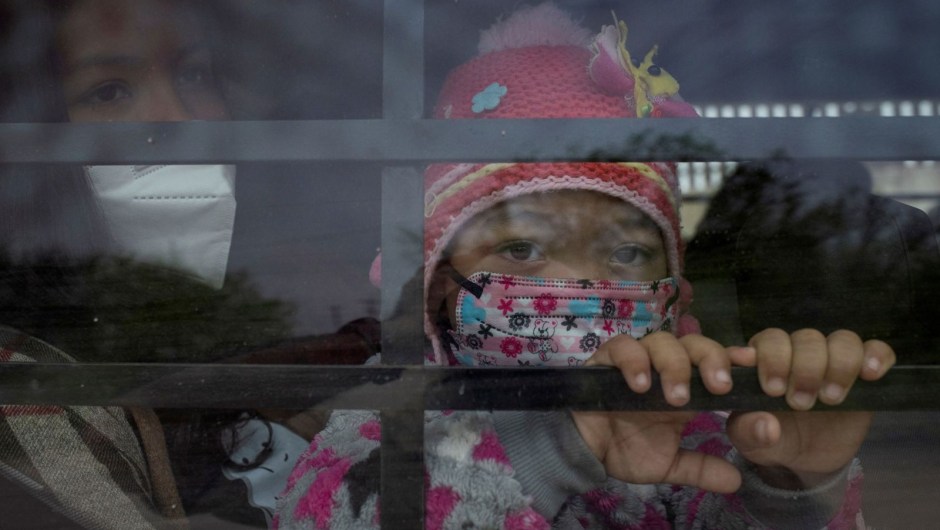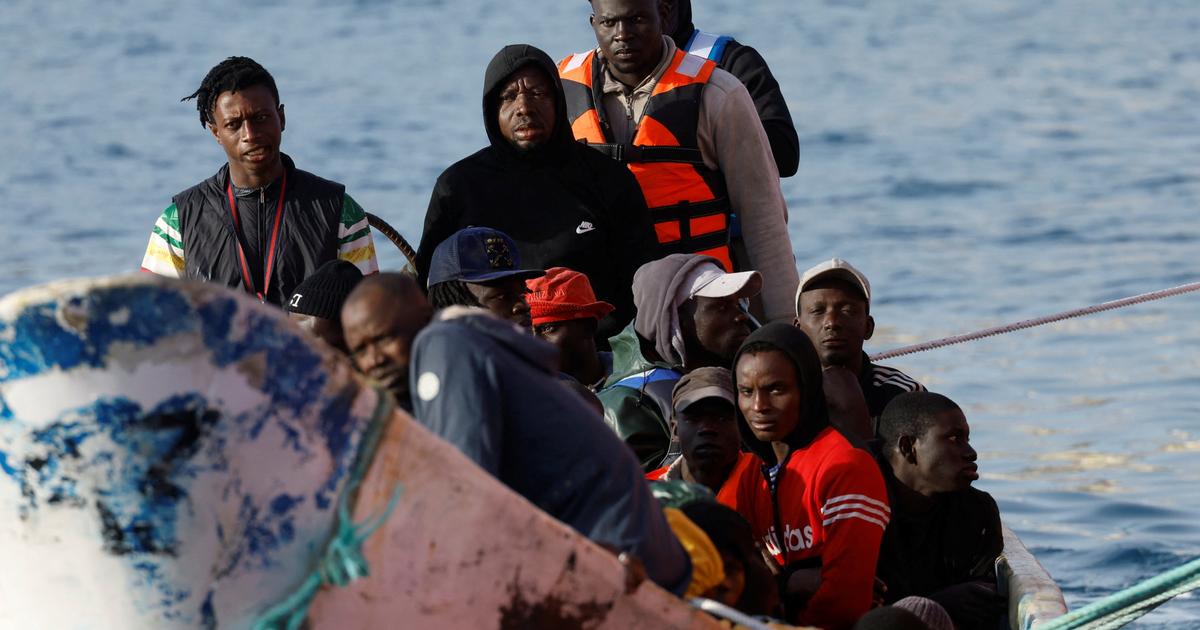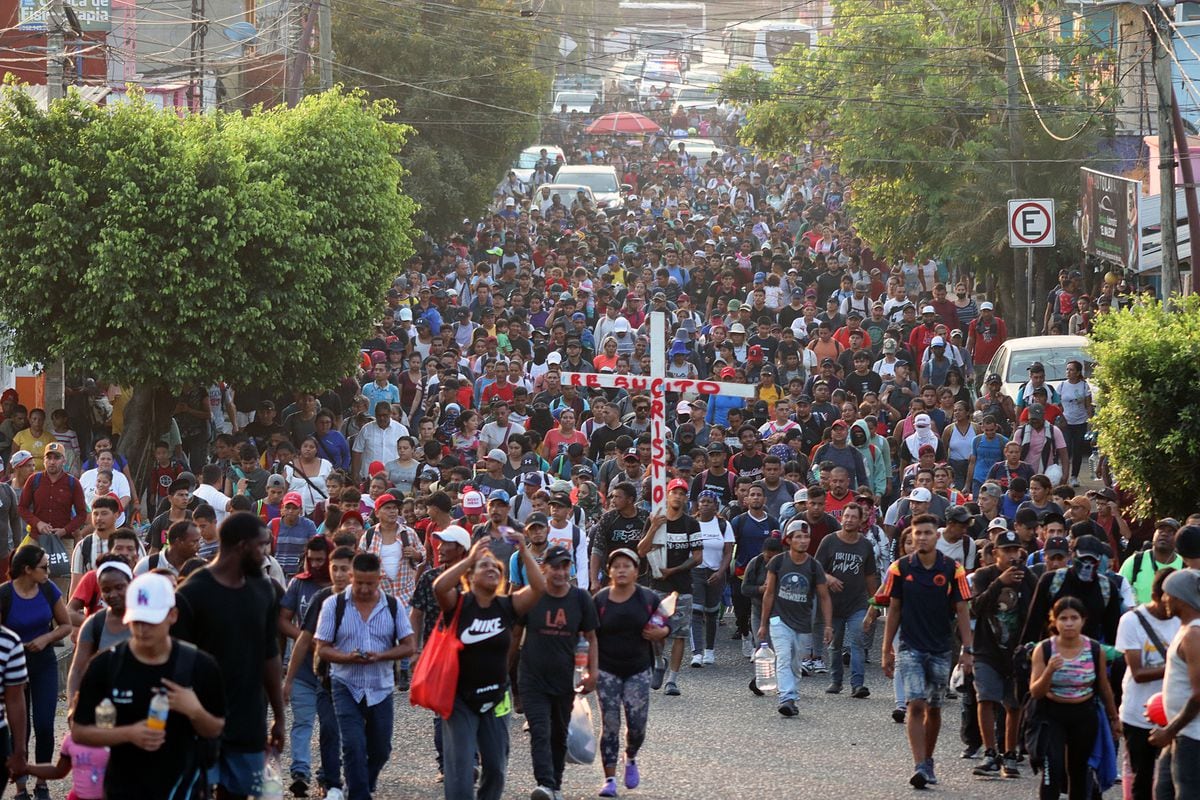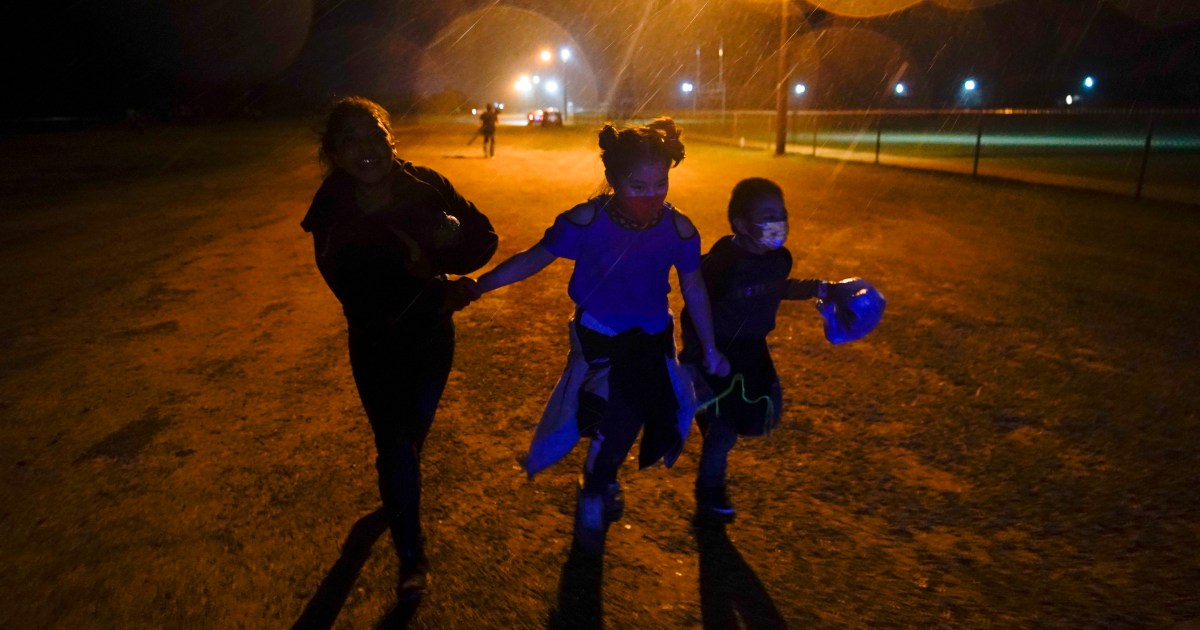A 4-year-old boy was walking alone on the US-Mexico border.
0:47
(CNN) -
Devastating tropical cyclones hit a region more than 1,000 miles from the US-Mexico border, wiping out homes, crops and jobs.
Months later, some migrants hoping to start over in the United States, heading to the Mexican border, say the hurricanes are a big reason behind their decision to head north.
“The house collapsed around us.
Thank God my mother survived, "a Guatemalan teenager told CNN through tears as he took his first steps in the United States.
«You always dream of living in a house with your children.
Now we have nothing, "said a Honduran mother from a bus station in Brownsville, Texas, after crossing the border with her 6-year-old daughter.
"[Hurricane] Eta, plus the pandemic, left us with nothing," a Honduran father told CNN en Español shortly after US authorities deported him and his family to Reynosa, Mexico.
These voices from the border are a reminder of two major contributors to this crisis that have not received much attention, even as the political debate intensifies: climate change and covid-19.
advertising
The powerful back-to-back hurricanes of November 2020 took a heavy toll on a region already suffering from the economic devastation of the pandemic.
That makes the current situation on the US-Mexico border even more complicated.
Families deported at the border say they are shocked and confused by Biden's immigration policies
The drama of immigrant children in the US does not yield 1:01
Two intense hurricanes displaced hundreds of thousands of people.
Now some of them are going to America
It's a possibility that Central American political leaders and climate migration experts began to warn as soon as Hurricane Eta and Hurricane Iota struck.
Months ago, a Honduran doctor who spoke to CNN said there was no doubt that tropical cyclones were going to generate more migration.
“So much famine is coming because the last harvest was lost.
There is no capacity to store anything.
Prices were already skyrocketing […] I don't want to think about what goes through the minds of those who lost everything, "said Dr. María Angélica Milla, a specialist in Nutrition, in November.
Get ready for the waves.
Climate change itself is rarely the only factor driving migration, says Kayly Ober, manager of the Climate Displacement Program at Refugees International.
But by exacerbating existing problems, you can influence people's decisions.
"In the case of hurricanes Eta and Iota, yes, the sheer intensity of scale and impact was definitely driven by climate change," he says.
"That caused an unprecedented level of destruction in some parts of the region."
The floods wiped entire communities in Nicaragua, Honduras and Guatemala off the map.
The houses were destroyed.
Millions of people were affected and hundreds of thousands were displaced.
Biden Administration Announces End of Trump-Era Rule Rejecting Certain Immigration Applications With Blank Spaces
Aid still awaits in Nicaragua 4 months after hurricanes 3:37
Phil Klotzbach, a Colorado State University hurricane researcher who monitors and analyzes hurricane trends around the world, told CNN last year that the fact that water temperatures were warm enough As to allow both hurricanes to intensify rapidly so late in the hurricane season, it was a clear sign of global warming.
Many migrants who have spoken to CNN in the past month have said tropical cyclones influenced their decisions to flee.
They have also mentioned other factors, such as the hope that a new American presidential administration will be more welcoming.
Families in the region were already "surviving a knife's edge" even before the hurricanes, facing food shortages and widespread violence, says Meghan López, regional vice president for Latin America for the International Rescue Committee.
"The hurricanes were […] the last in a series of what was a devastating year," he says, noting that tropical cyclones were part of a complicated combination of factors that fueled migration.
"To have the pandemic on top of that, to cut aid to the region, all these things create this pressure cooker where there is no escape valve," says López.
"And the only escape valve is to try to escape from the terrible situation in which people live […] People are making desperate decisions."
1 of 20
|
This aerial photo, taken on March 15, shows a temporary processing center established by US Customs and Border Protection in Donna, Texas.
Attorneys who recently spoke with children at the facility say they are terrified, crying and worried that they will not be able to call their parents.
Adrees Latif / Reuters
2 of 20
|
Yaretsi, a 4-year-old girl from Honduras, sits on the lap of her mother, Angie, as she gazes out the window of a U.S. Border Patrol vehicle on March 15.
They had just crossed the Rio Grande on a raft.
Adrees Latif / Reuters
3 of 20
|
Migrant mothers from Central America hold their children while waiting for transportation After crossing from Mexico to La Joya, Texas, on March 14 Adrees Latif / Reuters
4 of 20
|
Migrant families and unaccompanied minors from Central America take refuge in a makeshift processing center under the Anzalduas International Bridge in Granjeno, Texas, on March 12.
Adrees Latif / Reuters
5 of 20
|
Central American migrants await transportation in Penitas, Texas, on March 12.
Adrees Latif / Reuters
6 of 20
|
Unaccompanied minors are transported in a US Border Patrol vehicle after crossing the Rio Grande into the United States.
Authorities say the number of unaccompanied minors in the agency's custody has reached a record high.
Adrees Latif / Reuters
7 of 20
|
Traffickers use a raft to transport migrant families and children across the Rio Grande to Texas on March 6.
Adrees Latif / Reuters
8 of 20
|
Migrant families and children sit in the back of a police truck after crossing the Rio Grande on March 5.
Adrees Latif / Reuters
9 of 20
|
Migrants climb the banks of the Rio Grande toward the United States as traffickers on rafts prepare to return to Mexico on March 5.
Adrees Latif / Reuters
10 of 20
|
María, a 4-year-old girl from El Salvador, is held by her mother, Loudi, after they crossed the Rio Grande on March 5.
Adrees Latif / Reuters
11 of 20
|
A boy watches from a tent in Tijuana, Mexico, on February 27.
He is camped out with other migrants from Central America waiting to cross the border and request asylum in the United States.
Jorge Duenes / Reuters
12 of 20
|
Migrants from the Matamoros camp in Mexico arrive to cross the border bridge into the United States on February 26.
The camp was recently emptied after the Biden administration ended the Trump administration's migrant protection protocols, which forced many to wait in Mexico while their immigration cases made their way through US courts. César Rodríguez / Bloomberg / Getty Images
13 of 20
|
A U.S. Border Patrol agent takes a young asylum seeker and his family to a bus station in Brownsville, Texas, on February 26.
US immigration authorities are now releasing many asylum-seeking families after detaining them while crossing the US-Mexico border.
Immigrant families are free to travel throughout the US while they await asylum hearings.
John Moore / Getty Images
14 of 20
|
A U.S. Customs and Border Protection agent checks the name of a migrant, as a group of at least 25 asylum seekers from a migrant camp in Mexico were allowed to travel to the United States on February 25.
The group was the first to be allowed to cross into South Texas as part of the Trump administration's repeal of migrant protection protocols.
Many of the asylum seekers had been waiting in a camp along the Rio Grande for more than a year.
John Moore / Getty Images
15 of 20
|
Emma Moreno (right), a volunteer working at the Agape shelter in Tijuana, helps an asylum seeker verify the "Conecta" website of the United Nations High Commissioner for Refugees.
"Conecta" allows asylum seekers who have been trapped in Mexico under the Migrant Protection Protocols to enter the United States and await their asylum process there.
On the first day of launch, the website quickly became oversaturated when the estimated 25,000 people on the show tried to sign up.
Guillermo Arias / AFP / Getty Images
16 of 20
|
A migrant girl from Brazil seeking asylum in the United States sits on a bench inside a shelter in Ciudad Juárez, Mexico, on February 19.
José Luis González / Reuters
17 of 20
|
Asylum seekers wait outside the El Chaparral border port as they wait to cross into the United States from Tijuana on February 19.
The Biden administration is still turning away most migrants at the border, but officials are gradually allowing 25,000 people previously enrolled in the Migrant Protection Protocols program to enter Patrick T. Fallon / AFP / Getty Images
18 of 20
|
Migrants seeking asylum in the United States carry empty water jugs at a camp in Matamoros, Mexico, on February 18.Daniel Becerril / Reuters
19 of 20
|
Migrants cross the Rio Grande River to reach El Paso, Texas, from Ciudad Juárez, Mexico, on February 5.
Henrika Martínez / AFP / Getty Images
20 of 20
|
Teddy bears belonging to migrant girls are seen in the Rio Grande on February 5 after the girls applied for asylum in El Paso.
José Luis González / Reuters
The pandemic had already aggravated the problems in Central America
López says the pandemic, like the hurricanes that hit the region, exacerbated existing problems.
"If people were already experiencing violence, then they were locked in their communities, locked in their homes with that violence," she says.
"Covid has really just exacerbated every single problem people face in the region, and every risk factor for migration in the region, on many, many levels."
Another reason, Ober says, is that coping strategies that subsistence farmers would use to overcome economic hardships were no longer an option once the pandemic hit.
For example, during prolonged and repeated droughts in the region known as 'the dry corridor', it is common for farmers to temporarily move to cities for a season if their crops are experiencing problems.
An elderly woman sits outside a tent in Lima, Honduras, where she lives after losing her home in Hurricanes Eta and Iota last year. The devastation of cyclones and the economic damage from the COVID-19 pandemic have added to the forces driving Hondurans to migrate.
"With COVID-19, it was a double whammy," says Ober.
“If you moved to the city, there were lockdowns and you couldn't access those economic opportunities anymore.
It made it harder to overcome any kind of shock.
The pandemic pushed 22 million more people into poverty in Latin America last year, according to the United Nations Economic Commission for Latin America and the Caribbean, ECLAC.
That adds to the consequences for public health, which have also been devastating.
Migration has also hampered logistics at the border
In addition to worsening economic conditions in Central America, the pandemic has also contributed to a long delay at the US-Mexico border.
"He's playing a huge role," says Sarah Pierce, Policy Analyst at the Migration Policy Institute.
A growing number of unaccompanied minors are being detained in facilities that exceed the legal limit of 72 hours because shelters run by the Department of Health and Human Services (HHS) have not had enough space due to pandemic limitations. on how many people they can hold.
“The administration had limited HHS capabilities to house unaccompanied immigrant minors.
They had reduced the space of their beds by 40%.
Thousands of beds that would normally be available were not connected, ”says Pierce.
Although those capacity rules were recently lifted and shelters have been increased to house more people, he says, the process has been slow.
Another major complicating factor: The pandemic is ongoing, raising public health questions about the conditions in the facilities where immigrants are detained and how coronavirus tests are performed.
"There hasn't been much transparency about the testing process ... It's adding a layer of complexity to an already very challenging situation," says Pierce.
And the government has not given the media access to the Customs and Border Protection facilities where many immigrants are being held, so there is still much we do not know about what is happening behind closed doors.
- Rosa Flores, Gustavo Valdés, Natalie Gallón, Priscilla Alvarez, Geneva Sands and Ashley Killough of CNN contributed to this report.
climate changeHurricane EtaHurricane IotaInstaNews


/cloudfront-eu-central-1.images.arcpublishing.com/prisa/PBMVWQBLQRD6RCIWTKBVIUEINA.jpg)






